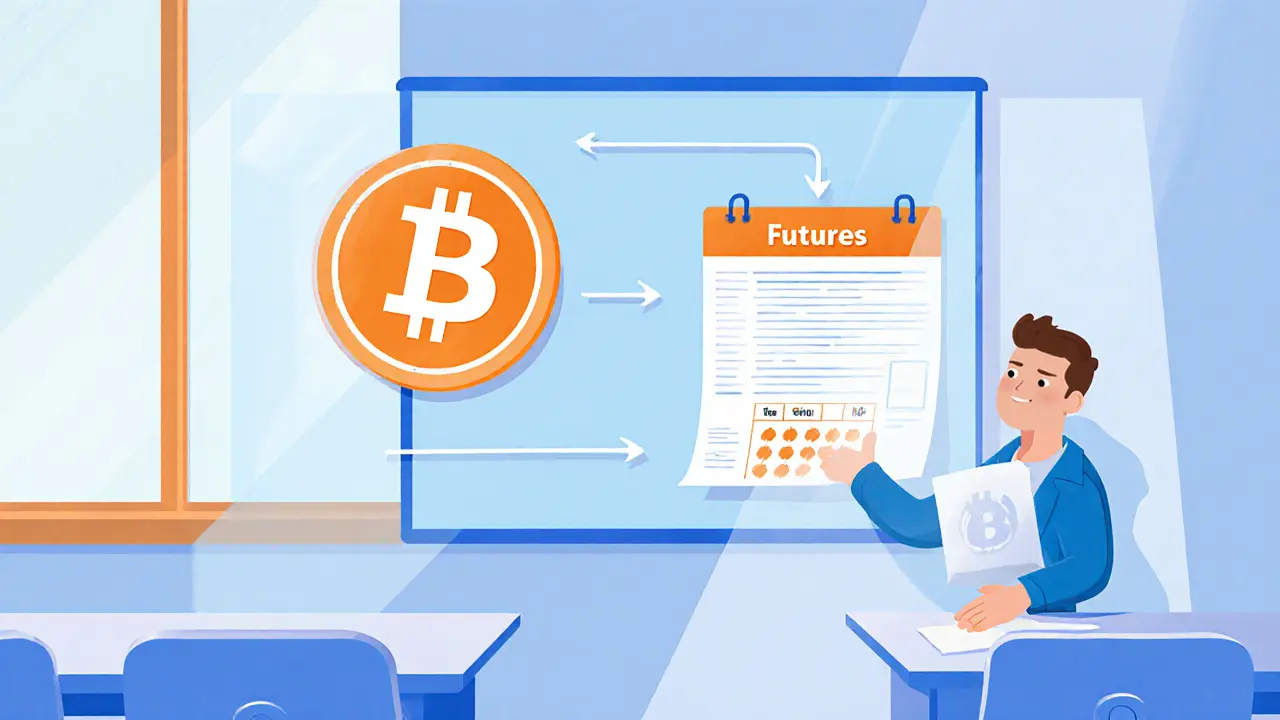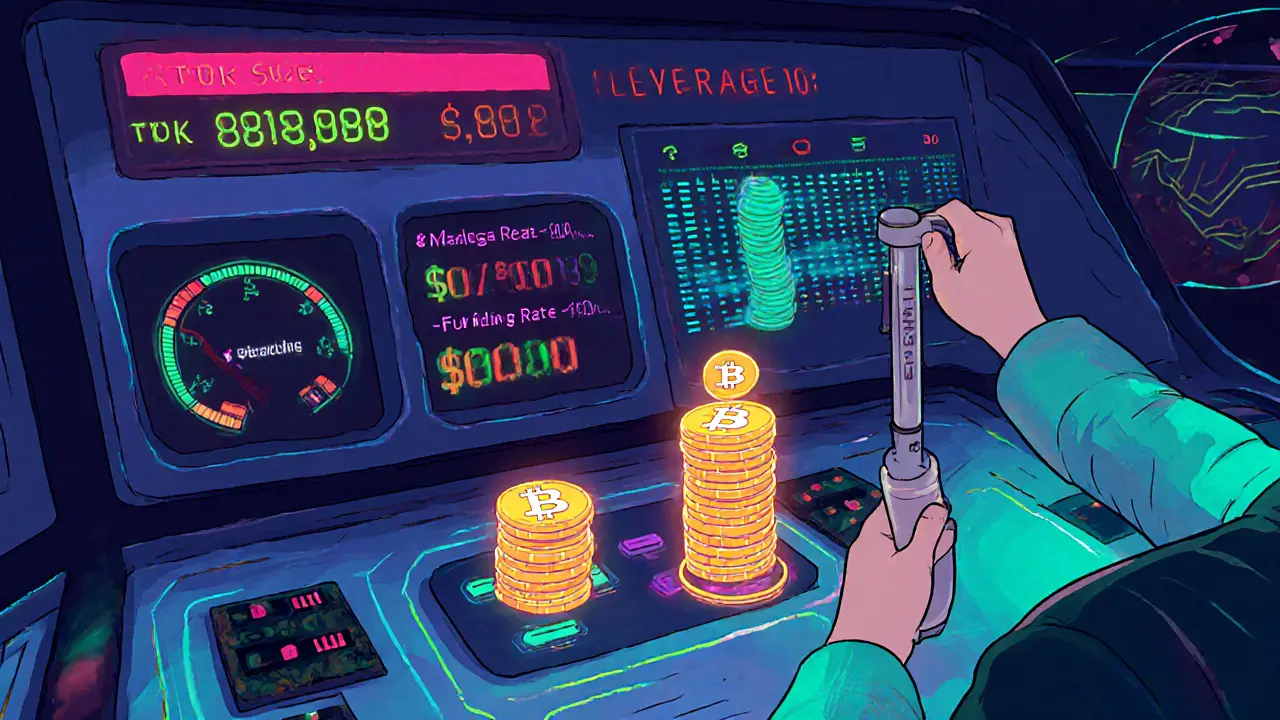Understanding Cryptocurrency Futures: How They Work, Benefits & Risks

Cryptocurrency Futures Calculator
Your Results
Enter values and click Calculate to see your potential profit or loss.
About This Calculator
This tool demonstrates how leverage affects your potential gains and losses in cryptocurrency futures. Remember that higher leverage increases both potential rewards and risks. Always manage risk appropriately.
Ever wondered how traders can profit from Bitcoin’s price swings without actually owning a single coin? That’s the core idea behind cryptocurrency futures. These contracts let you lock in a price for a crypto asset at a future date, giving you exposure to its moves while keeping the underlying token out of your wallet. In the next few minutes, you’ll discover what crypto futures are, why they matter, and how you can start using them wisely.
Quick Overview
- Crypto futures are standardized contracts to buy or sell a set amount of a cryptocurrency at a predetermined price on a set future date.
- They provide three main functions: hedging, speculation, and arbitrage.
- Most contracts settle in cash, using a reference price rather than delivering the actual crypto.
- Leverage lets you control large positions with a fraction of the capital, but it also magnifies losses.
- Key players include CME Group, Kraken Pro, Binance, and other regulated exchanges.
How Crypto Futures Work
When you open a futures position, you aren’t buying Bitcoin itself. Instead, you’re entering a legally binding agreement that specifies:
- The underlying cryptocurrency (e.g., Bitcoin, Ethereum).
- The contract size - how many units of the crypto the contract represents.
- The expiration date - when the contract will be settled.
- The price at which the contract will be settled (the "strike price").
On the expiration day, the contract settles either in cash or, rarely, by delivering the actual cryptocurrency. Most platforms, like Kraken Pro is a crypto‑focused exchange that offers futures trading alongside spot markets, use cash settlement. This means you receive or pay the difference between the contract’s strike price and the official reference price, usually taken from the CME’s settlement index.
Because contracts are standardized, exchanges can match buyers and sellers automatically. You never deal directly with the counter‑party; the exchange acts as an intermediary, guaranteeing performance.
Key Features & Contract Specs
Every futures contract has a set of technical specifications that dictate how it behaves. Below is a quick reference for the most common elements:
- Tick size: The smallest price movement allowed. For Bitcoin futures on CME, each tick equals $0.01 and translates into a dollar value based on contract size.
- Leverage ratio: Determines how much capital you need to open a position. A 10x leverage means you only need 10% of the contract’s notional value as margin.
- Funding rate (for perpetual futures): Regular payments exchanged between long and short positions to keep the contract price close to the spot price.
- Trading hours: Crypto futures trade nearly 24/7, unlike traditional CME futures that pause on weekends and holidays.
- Settlement method: Cash‑settled contracts use a reference price; physically settled contracts would transfer actual crypto, which is rare.
Here’s a side‑by‑side look at three popular contract types:
| Feature | Bitcoin Futures (CME) | Ethereum Futures (CME) | Perpetual Futures (Crypto‑Native) |
|---|---|---|---|
| Contract Size | 5 BTC per contract | 50 ETH per contract | Varies (often 1 BTC or 1 ETH) |
| Leverage | Up to 20x | Up to 15x | Up to 100x (platform dependent) |
| Expiration | Quarterly (Mar, Jun, Sep, Dec) | Quarterly | No expiration (continuous) |
| Settlement | Cash‑settled | Cash‑settled | Funding‑rate adjusted cash settlement |
| Trading Hours | 24/5 (CME closes weekends) | 24/5 | 24/7 |

Benefits & Use Cases
Why would anyone trade a derivative instead of buying the actual coin? Here are the most common reasons:
- Hedging: If you own a large amount of Bitcoin on your balance sheet, you can sell futures to lock in a price and protect against a sudden drop. Companies that accept crypto payments often use this strategy.
- Speculation: Traders can profit from both rising and falling markets by going long (buy) or short (sell). The ability to short easily is a key advantage over spot markets.
- Leverage: With a modest amount of margin, you can control a much larger exposure, amplifying potential returns. For example, a 5% move in Bitcoin can translate to a 50% gain on a 10x leveraged position.
- Arbitrage: Price differences between spot, futures, and perpetual markets create opportunities to lock in near‑risk‑free profits. Skilled traders monitor these spreads constantly.
- Price Discovery: Futures prices often lead spot prices, reflecting market expectations about future supply and demand. Analysts watch the CME Bitcoin futures curve to gauge sentiment.
Risks & Risk Management
High reward comes with high risk. Crypto futures are notoriously volatile, and leverage can wipe out your account in a single move.
Key risk factors include:
- Liquidation: If your margin falls below the maintenance requirement, the exchange automatically closes your position, often at an unfavorable price.
- Funding Rate Swings: In perpetual contracts, a rapidly changing funding rate can add or subtract significant amounts from your P&L each hour.
- Market Gaps: Sudden news (e.g., regulatory announcements) can cause price gaps that bypass stop‑loss orders.
- Regulatory Changes: The CFTC is the U.S. Commodity Futures Trading Commission, overseeing futures markets and enforcing regulations may tighten margin rules or impose new reporting requirements that affect liquidity.
Effective risk management strategies:
- Never risk more than 1-2% of your account on a single trade.
- Use stop‑loss orders and be prepared for slippage.
- Keep leverage low until you master contract mechanics - many professionals start with 2x or 3x.
- Monitor funding rates continuously if you hold perpetual positions.
- Maintain a diversified portfolio; don’t put all capital into one crypto future.
Getting Started & Platform Choices
Ready to dip your toes in? Here’s a step‑by‑step checklist:
- Choose a regulated exchange. The CME Group is a leading derivatives exchange offering Bitcoin and Ethereum futures under U.S. regulatory oversight is the go‑to for institutional traders, while Binance is a global crypto exchange that provides both futures and perpetual contracts to retail users caters to retail and offers higher leverage.
- Complete KYC/AML verification - required for all major platforms.
- Deposit margin: usually in USD, USDT, or your chosen crypto.
- Familiarize yourself with the contract specifications page - pay attention to tick size, expiry, and settlement method.
- Start with a “paper” or demo account if the platform offers one; practice order entry and margin calculations.
- Open a small position, set a stop‑loss, and watch how funding rates affect your overnight P&L.
Most traders spend 20-30 hours per week monitoring positions because crypto markets never sleep. If you can’t devote that time, consider automated strategies or limit your exposure.
Future Outlook
The crypto futures market is still evolving. In 2024, daily derivatives volume topped $100billion, with futures making up roughly 60% of that figure. The CME has rolled out micro‑futures contracts, allowing investors to trade as little as 0.1BTC, lowering the entry barrier.
Regulators are sharpening their focus. A 2025 rule proposal in the U.S. could raise margin requirements for retail accounts, potentially dampening leverage but improving safety. Meanwhile, institutional giants like Fidelity and BlackRock are integrating crypto futures into their multi‑asset platforms, signaling a move toward mainstream acceptance.
Looking ahead to 2030, analysts forecast that crypto derivatives could handle over $1trillion in annual trading volume, provided the regulatory environment stabilizes and new products-such as options on futures or CBDC-linked contracts-gain traction.

Frequently Asked Questions
What is the difference between a futures contract and a spot purchase?
A spot purchase means you own the actual cryptocurrency and can transfer or spend it. A futures contract gives you exposure to price movements without owning the asset; it settles in cash or, rarely, by delivering the crypto at a future date.
Do I need to own Bitcoin to trade Bitcoin futures?
No. Futures are standalone products. You can profit from price changes whether you own Bitcoin or not, as long as you meet the margin requirements.
How does the funding rate affect perpetual futures?
Funding rates are periodic payments exchanged between long and short positions. When the perpetual price trades above the spot price, longs pay shorts; when it trades below, shorts pay longs. These payments keep the perpetual price anchored to spot.
Can I lose more than my initial margin?
With most regulated exchanges, your loss is capped at the margin you posted, because the exchange will liquidate the position before the deficit grows. However, on some crypto‑native platforms, rapid price gaps can cause “negative balance” events if liquidation fails.
Is crypto futures trading regulated?
In the United States, futures listed on CME fall under CFTC oversight, offering investor protections similar to traditional derivatives. Many overseas exchanges operate under their national regulations, which may be less stringent.

13 Comments
Crypto futures can be powerful but you need to respect margin limits and never overexpose your account.
While the allure of leveraged exposure is evident, prudence must govern each entry. One must first assess the notional value relative to available capital. Subsequently, the chosen leverage should reflect personal risk tolerance, not merely market optimism. It is also advisable to position stop‑loss orders commensurate with anticipated volatility. Moreover, the distinction between cash‑settled and physically settled contracts bears significance for portfolio accounting. In sum, disciplined preparation supersedes speculative impulse.
Totally get it! Keep those limits in check and you’ll stay in the game for the long haul.
When choosing a venue for crypto futures, consider both regulated exchanges like CME for institutional safety and crypto‑native platforms such as Binance for higher leverage and 24/7 access. Each has distinct settlement methods, fee structures, and margin requirements, so reading the contract specifications is essential before committing capital.
That’s a solid point – I’ve found the CME contracts reassuring because they sit under clear U.S. oversight, yet the flexibility of Binance’s perpetuals can be a game‑changer for retail traders. The key is to match the exchange’s risk profile with your own, and always double‑check the tick size and funding rate before you go live.
It is incumbent upon every participant in the cryptocurrency futures arena to recognize that the seductive promise of amplified returns carries with it an equally amplified moral responsibility. The modern trader, intoxicated by the prospect of rapid gains, often neglects the foundational tenets of capital preservation and prudential stewardship. One must internalize that leverage, while a potent instrument, is fundamentally a double‑edged sword capable of cutting both ways with unforgiving immediacy. When a position is opened with a ten‑fold multiplier, the margin cushion shrinks to a fraction of the underlying exposure, leaving the account vulnerable to even modest market oscillations. In the event of a sudden adverse price swing, liquidation mechanisms can trigger at rates that erode the remaining equity in a matter of seconds, a phenomenon that no amount of hindsight can amend. Furthermore, the psychological pressure exerted by near‑instaneous margin calls often leads to irrational decision‑making, compounding the original misstep. It is therefore essential that each trader cultivates a disciplined risk‑management framework, anchored by predetermined stop‑loss thresholds and a willingness to accept small, controlled losses as part of the broader strategic tapestry. Ignoring these safeguards not only imperils personal wealth but also contributes to systemic instability within the broader market ecosystem. The collective health of the futures market hinges upon a culture of responsibility, where participants refrain from reckless speculation that can ripple through liquidity pools and affect counterparties. In addition, regulatory bodies across jurisdictions have begun to underscore the importance of transparent reporting and adequate capital buffers, further emphasizing that the era of unfettered leverage without oversight is waning. Consequently, the prudent trader must stay abreast of evolving compliance standards, integrating them into their operational protocols. Ultimately, the convergence of personal discipline, robust risk controls, and adherence to regulatory guidance forms the triad upon which sustainable futures trading is built. To ignore any one of these pillars is to court disaster, both at the individual and systemic levels.
You've articulated the ethical dimension beautifully. A practical step is to set a fixed percentage of your portfolio as the maximum allowable margin at any time. Additionally, employing trailing stops can lock in gains while still providing downside protection. Regularly reviewing position sizing against recent volatility metrics further refines risk control. By embedding these habits, the theoretical framework becomes actionable daily.
Good points. Keep it simple and stick to your plan.
Effective risk management remains the cornerstone of sustainable futures trading.
Ah, the intoxicating dance of leverage, a siren's call that beckons the brave, the reckless, the audacious-yet, oh, how often it spells tragedy, catastrophe, ruin! One must, with solemn reverence, behold the margin call, that looming specter, that inexorable tide, that merciless harbinger of loss! The funding rate, that capricious tide, shifts like the winds of fate, rewarding the bold, punishing the naive, and all the while the market, ever‑volatile, spins its endless roulette wheel, glittering with promise, dripping with peril, inviting the unguarded to gamble beyond reason. Let us not be seduced by the glittering façade of exponential profit; rather, let discipline, patience, and prudence be our steadfast companions, our bulwarks against the storm of over‑extension that threatens to capsize even the mightiest of traders.
I completely agree with the vivid warning. For anyone feeling the pull of high leverage, start with modest multipliers-2x or 3x-while you get comfortable with the mechanics. Track your position’s equity curve daily, and treat each loss as a learning data point rather than a setback.
From a quantitative perspective, the funding rate differential can be modeled as a mean‑reverting process, where deviations from the spot‑price parity create arbitrage opportunities for arbitrageurs equipped with statistical hedging scripts; however, latency, order‑book depth, and slippage risk must be factored into any execution algorithm to avoid negative balance scenarios during extreme market dislocations.
While your technical exposition is commendable, let us not ignore the broader philosophical implications of such an ecosystem that glorifies speculative excess. The very architecture of perpetual futures, with its perpetual funding mechanisms, perpetuates a feedback loop that rewards short‑term capital extraction over genuine value creation. This, in turn, erodes the foundational trust that any mature financial market requires. Consequently, the onus falls upon the discerning participant to transcend mere algorithmic arbitrage and to cultivate a holistic understanding that balances quantitative acuity with ethical foresight.